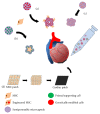Promising Therapeutic Strategies for Mesenchymal Stem Cell-Based Cardiovascular Regeneration: From Cell Priming to Tissue Engineering
- PMID: 28303152
- PMCID: PMC5337882
- DOI: 10.1155/2017/3945403
Promising Therapeutic Strategies for Mesenchymal Stem Cell-Based Cardiovascular Regeneration: From Cell Priming to Tissue Engineering
Abstract
The primary cause of death among chronic diseases worldwide is ischemic cardiovascular diseases, such as stroke and myocardial infarction. Recent evidence indicates that adult stem cell therapies involving cardiovascular regeneration represent promising strategies to treat cardiovascular diseases. Owing to their immunomodulatory properties and vascular repair capabilities, mesenchymal stem cells (MSCs) are strong candidate therapeutic stem cells for use in cardiovascular regeneration. However, major limitations must be overcome, including their very low survival rate in ischemic lesion. Various attempts have been made to improve the poor survival and longevity of engrafted MSCs. In order to develop novel therapeutic strategies, it is necessary to first identify stem cell modulators for intracellular signal triggering or niche activation. One promising therapeutic strategy is the priming of therapeutic MSCs with stem cell modulators before transplantation. Another is a tissue engineering-based therapeutic strategy involving a cell scaffold, a cell-protein-scaffold architecture made of biomaterials such as ECM or hydrogel, and cell patch- and 3D printing-based tissue engineering. This review focuses on the current clinical applications of MSCs for treating cardiovascular diseases and highlights several therapeutic strategies for promoting the therapeutic efficacy of MSCs in vitro or in vivo from cell priming to tissue engineering strategies, for use in cardiovascular regeneration.
Conflict of interest statement
The authors declare that they do not have any conflict of interests.
Figures


References
-
- Meads C., Cummins C., Jolly K., Stevens A., Burls A., Hyde C. Coronary artery stents in the treatment of ischaemic heart disease: a rapid and systematic review. Health Technology Assessment. 2000;4(23):1–153. - PubMed
Publication types
LinkOut - more resources
Full Text Sources
Other Literature Sources

